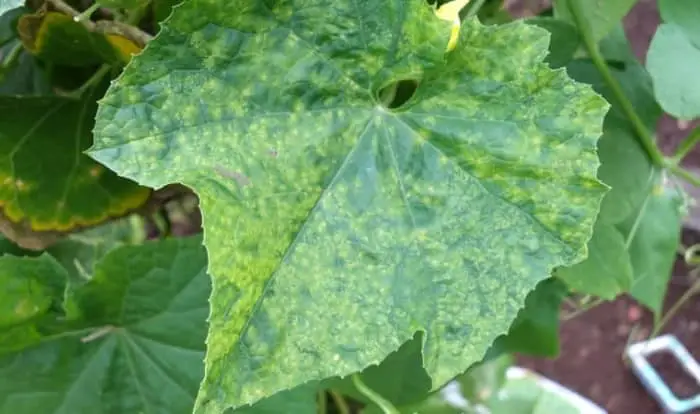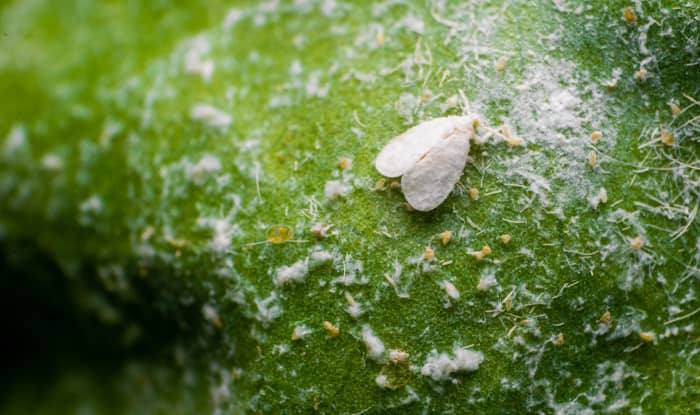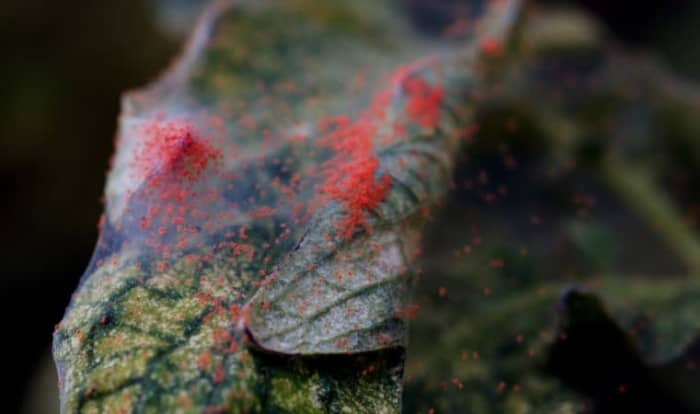Cucumbers are one of the most popular crops grown in vegetable gardens.
And most of the time they’re easy to grow. Give them enough sunlight and water and they’re great producers.
But sometimes, things go wrong.
Plants wilt. Leaves start to lose their color. And fruit grows stunted and deformed.
To help you get to the bottom of your cucumber plant problems, we’ve compiled this guide to the most common issues that get in the way of a successful harvest. With suggestions for how you can prevent and treat struggling plants.
Let’s dive in.
Common Cucumber Problems
These are some of the more common problems that people run into when growing cucumbers. They’re easy to solve once you identify them:
Wilting After Transplant
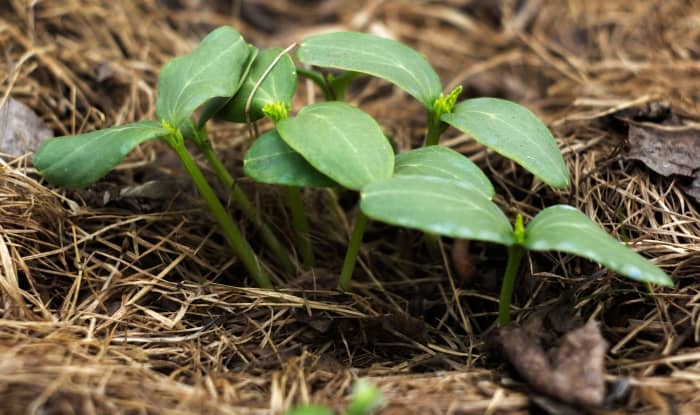
Many people start their cucumber seedlings indoors before moving them into their garden. But you might get better results planting the seeds outside instead.
The problem with starting them indoors and then moving them outside is the risk of causing transplant shock.
It’s easy to damage the roots while moving them. This affects the plant’s ability to uptake water, nutrients, and oxygen from the soil. And it will negatively affect its health, leading to growth problems, wilting of the cucumber plants, and maybe death.
Another common problem is sudden exposure to outside conditions. The change in temperature can cause a shock to young plants, as can the new experience of wind and rain.
If you choose to start them indoors and then move them outside, remember to harden them off.
One way to do this is to move them into a greenhouse first so they can slowly adapt. This will keep them warm during the colder temperatures at night.
You can also gradually introduce them to the outside. Bring them out during the day and place them in the shade, in an area of your garden that’s sheltered from the wind.
When temperatures start to drop in the evening you can bring them inside again.
Day by day, slowly increase the amount of time they spend in the sun. A couple of weeks is usually enough time to harden them off before you transplant them into the ground.
You can avoid the problems of transplant shock when you plant cucumber seeds outside. But if you live in an area with a cold climate and short growing season, this might not be possible. Cucumber plants die if they’re exposed to frost.
Temperatures under 50°F will cause your plant to wilt with yellowing and browning of the leaves. And the seeds will struggle to germinate at soil temperatures under 60°F, and plants will stop growing.
No Fruit – Or Deformed & Undersized
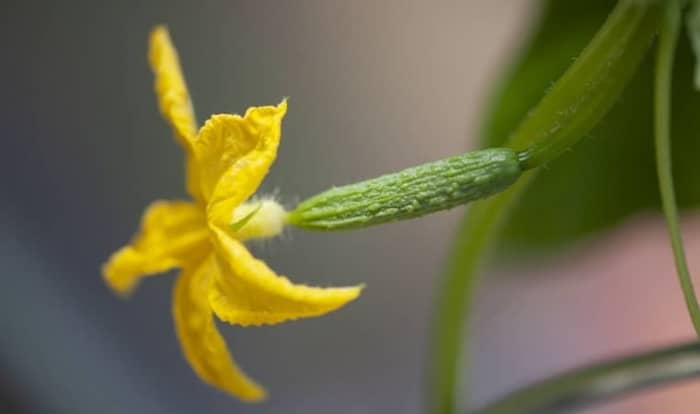
Female cucumber flowers are easy to identify: they’re the ones that have a small cucumber directly behind them.
In order for it to grow into a mature cucumber fruit, the flower needs to be pollinated with pollen from the male flowers.
Because cucumber pollen is very sticky it’s not carried by the wind. Instead, it rubs off onto pollinators, such as bees, who transfer it to the female flower.
If your baby cucumbers shrivel and die on the vine, then it’s probably because the female flowers are not getting pollinated adequately.
Poor pollination can also result in deformed and undersized cucumbers.
You can encourage more pollinators into your garden by planting pollen and nectar-rich flowers that bloom during the growing season.
And lay off the pesticides. They kill bees and other pollinating insects that you need in your garden. If you must use them, be very careful not to spray them around open flowers.
If this doesn’t work, you can also take care of the job yourself by hand.
Leaves Wilting In The Sunlight, & The Edges Turning Brown & Crispy
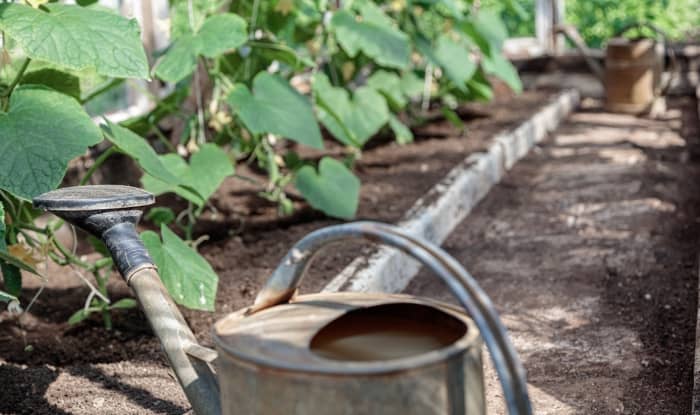
Your cucumbers need a lot of water for healthy growth. If they become dehydrated they start to wilt in the sunlight. And eventually, they’ll dry up and die.
Make sure they get 1-2 inches of water each week. A good test to see if they need watering is to feel the top inch of the soil. When it starts to feel dry you should water them again.
Direct the water around the base so that you soak the top 6-8 inches of soil where the majority of the roots are. If the soil is drying too fast in the heat, you can keep it moist by adding a layer of mulch around them.
Cucumbers prefer to have occasional, deep watering because they don’t like sitting in soggy ground. It prevents their roots from getting access to oxygen. So you have to be careful not to overwater them.
Symptoms of overwatering include yellowing of the cucumbers and leaves, with the edges turning brown and crispy.
If they continue to sit in wet soil then fungal infections and the development of root rot become a problem.
If you’re growing cucumbers in containers, then it’s important to make sure the drainage holes and the potting soil allow easy and fast drainage. You should be able to see water running from the bottom after you water.
Stunted Cucumber Growth & Poor Yield
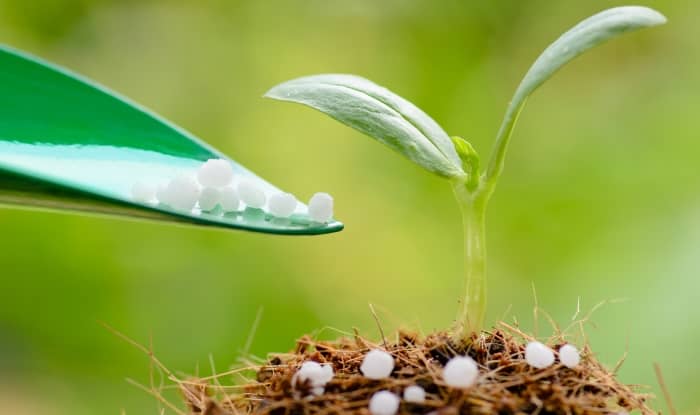
Cucumbers use a lot of nutrients from the soil as they grow. And deficiencies can lead to stunted growth, reduced fruit yield, and the leaves losing their color.
Try feeding them occasionally with plant food. Cucumber plants use more potassium than nitrogen and phosphorus, but all are required for healthy growth. So aim for an NPK ratio of something like 5-5-10.
An alternative choice is to use an organic fertilizer that has a full range of essential nutrients.
Another common deficiency is a lack of magnesium. But you can correct this by using Epsom salt for cucumbers.
Nutrient depleted soil is common in containers. So make sure you fertilize the soil regularly.
Defoliation & Mold – Whiteflies
Whiteflies are a familiar pain for gardeners. These tiny airborne creatures like to feed on cucumber leaves, sucking out the sap and weakening the plant.
Whiteflies leave behind a sticky secretion known as honeydew, causing many problems, including the proliferation of mold that covers the foliage. The damage whiteflies inflict significantly undermines the vitality of your plants, leading to diminished yields. They’re also carriers of diseases that can affect the plants in your garden.
You can find whiteflies in clusters on the undersides of leaves, making them easy to detect. And fortunately, they’re not hard to get rid of. One of the most natural approaches involves the introduction of insects that feed on whitefly to your garden’s ecosystem. Ladybugs are renowned for their appetite for insects, including aphids and whiteflies, making them an excellent addition to any garden.
You can usually get them from most garden centers. Or you can entice them into your garden by cultivating colorful flowers such as marigolds. You can also use horticultural oils instead of chemical insecticides.
Yellow & Tan Spots And Leaves Drying Out – Spider Mites
Spider mites can be a significant nuisance for cucumber plants, causing various problems and detrimental effects. These tiny arachnids can multiply rapidly and wreak havoc if left unchecked.
Spider mites feed on sap, puncturing the plant cells and extracting the vital fluids. This continuous feeding weakens the plants, leading to stunted growth. Plants affected by spider mites may appear smaller, less vigorous, and fail to reach their full potential.
As spider mites pierce the plant cells and extract the sap, they cause damage to the chlorophyll, which is responsible for the green coloration. This damage manifests as the yellowing or bronzing of the cucumber leaves. If left, they may eventually turn brown and dry out.
The feeding activities of spider mites disrupt the normal functioning of cucumber leaves, impairing their ability to carry out photosynthesis effectively, resulting in further weakening and diminished yields.
Spider mite infestations also make plants more susceptible to various diseases. The feeding damage inflicted by spider mites creates entry points for pathogens, increasing the risk of infections and further compromising plant health and yield.
To prevent and manage spider mite infestations pay close attention to your plants. Early detection allows for prompt intervention. Try introducing natural predators such as predatory mites and ladybugs to control spider mite populations.
Also, maintaining proper plant hygiene, ensuring adequate air circulation, and avoiding excessive nitrogen fertilization can help deter spider mites and minimize their impact.
Brown Spots With A Yellow Halo – Alternaria Leaf Blight
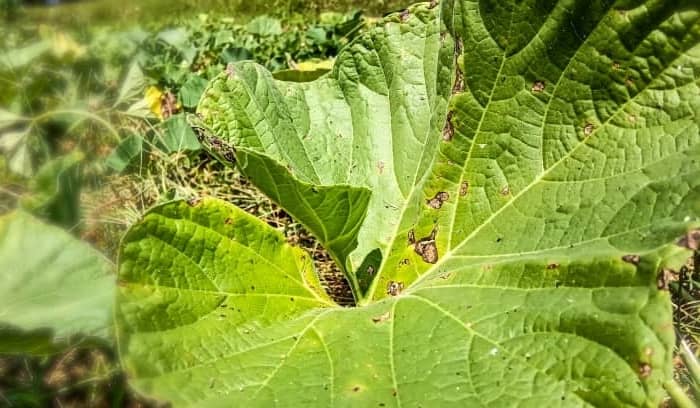
Cucumber leaf infected by Alternaria cucumerina
Alternaria leaf blight (Alternaria cucumerina) is a fungus that’s more often found on melons. But it affects cucumbers as well.
You’ll notice small brown spots appear on the leaves. These grow over time into larger shapes with a yellow halo surrounding them.
As the disease progresses, the cucumber leaves become brown, wilt, and die.
If you identify it early you can take action to stop the spread by removing the affected parts.
An alternative is to use a fungicide. Chemical fungicides make the cucumbers inedible, so many gardeners choose copper fungicides.
If the infection is severe, it’s usually best to remove the plant and sterilize or replace the soil before replanting.
Yellow Circles That Grow In Size – Anthracnose
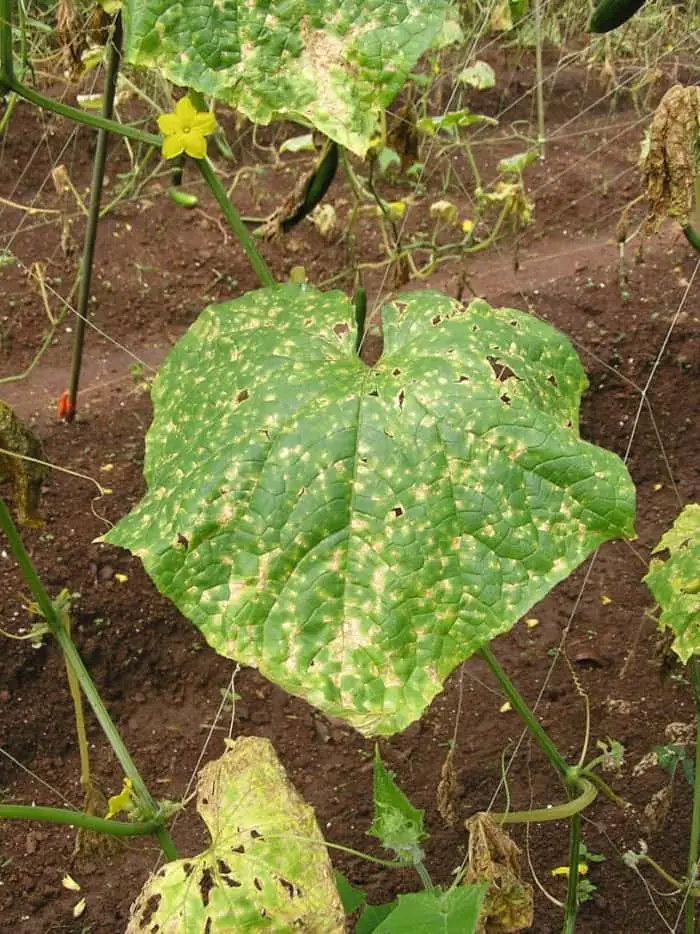
Anthracnose infection of cucumber plant
With anthracnose (Colletotrichum orbiculare), you’ll see small yellow circles that grow as the disease progresses. The edges of the circles are dark brown or black.
This fungus also affects the cucumbers growing on the vine. With salmon-colored fungal spores appearing in the middle of black spots.
If you want to save the plant and don’t mind throwing away the fruit you can use a fungicide such as Bravo.
But this might not be worthwhile for heavily infected plants. So it’s often best to just throw them away instead.
Bacterial Leaf Spots

Pseudomonas syringae infection of hibiscus leaf
The bacteria responsible are spread by insects as they feed on the cucumber leaves. They usually thrive in cool, wet conditions.
The spots that appear at the site of infection differ depending on exactly which bacteria is causing the infection:
- Pseudomonas syringae – red-brown spots that turn black
- Septoria cucurbitacearum – beige-white spots with a brown border
- Xanthomonas campestris – brown spots with a yellow border that turn black
The infected areas are vulnerable to further infection by fungi and other pathogens. And as the condition progresses some of the leaves may fall off, exposing the cucumbers to sunscald.
There’s no effective treatment, so prevention is important. Which means stopping the insects.
Wilting, Yellowing Leaves – Bacterial Wilt
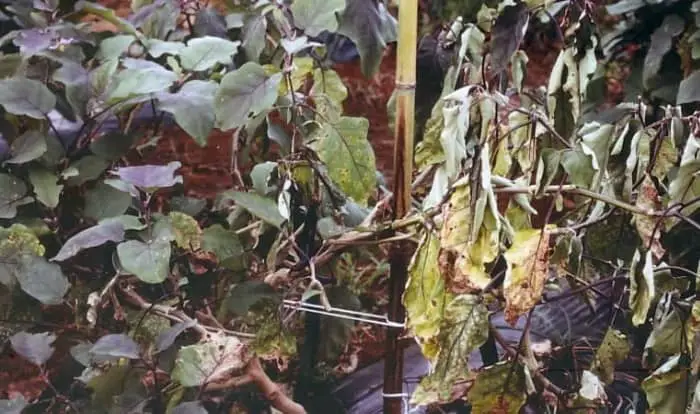
Bacterial wilt of eggplant
Keeping an eye out for cucumber beetles will help you stop bacterial wilt (Erwinia tracheiphila). They’re the main carrier of the bacteria responsible, spreading it as they feed.
Finding the beetles early and taking steps to reduce their numbers in your garden is important. Because there’s no effective treatment, and a beetle infestation will spread it quickly.
The beetles grow to about ½ inch and are easy to identify. They’re bright yellow. And they come in 2 different types, the striped cucumber beetle, and the spotted cucumber beetle.
After infection, you’ll notice the cucumber plant leaves changing to yellow, becoming dehydrated, and wilting.
To prevent the cucumber beetle infestations, you should remove them when you find them. This can keep numbers down, but you might need to do more.
Other methods of prevention you can try include:
- Row covers to stop them from getting at the plants—but remember to remove the cover when it’s time for the flowers to bloom or you’ll prevent pollination
- Insecticides such as Entrust (spinosad) and Sevin (carbaryl)
- Clearing weeds from your garden and laying down mulch around the plants to stop them laying eggs
- Use yellow sticky traps to catch the cucumber beetles
Mottled Leaves – Cucumber Mosaic Virus
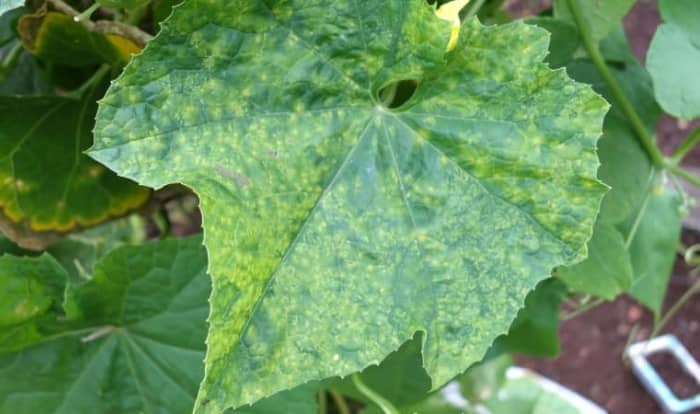
Cucumber mosaic virus on cucumber leaf
Cucumber mosaic virus is mostly spread by Aphids. But other insects, such as cucumber beetles, can also spread it from plant to plant as they feed.
The cucumber leaves become wrinkled and develop yellow spots. With new leaves and fruit becoming stunted and deformed.
Fruit yield is also affected. But don’t try to eat the sickly white cucumbers, they’re only good for throwing away.
There’s no effective treatment for infected plants. So it’s best to remove and destroy them.
Making use of virus-resistant varieties of cucumbers is a good idea if you’ve had problems with this disease before.
Angular Yellow Leaf Spots – Downy Mildew
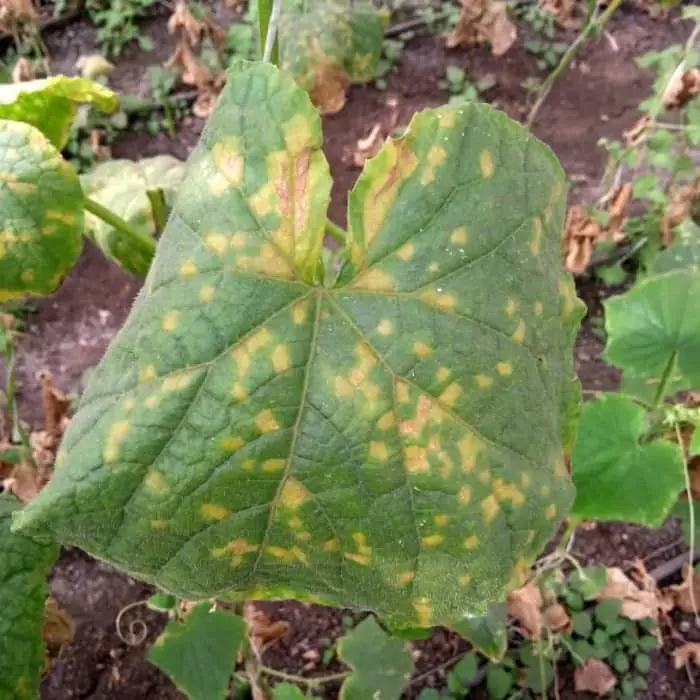
Downy mildew on cucumber leaf
Downy mildew (Pseudoperonospora cubensis) is a fungal infection common on cucurbits, usually occurring in shaded and damp areas.
Angular yellow spots appear on the leaves. And they dry out and turn brown as the disease progresses. Eventually, the leaves fall off the plant.
You can find the fungal spores growing on the underside of the leaves. They’re visible as dark gray spots with a slightly purple appearance.
To control the spread of the fungus, remove the infected parts of the plant. And fungicides such as Curzate, Zampro, and Orondis can also work.
Yellow-Brown, Dehydrated, Wilting Leaves – Fusarium Wilt

Fusarium wilt of tobacco plant R.J. Reynolds Tobacco Company Slide Set, CC BY 3.0
Fusarium wilt (Fusarium oxysporum) is different from most fungi that grow on cucumber plants. Instead of growing best in moist conditions and moderate temperatures, this fungus thrives in hot and dry conditions.
It’s transferred by insects and contaminated water. And if you’re not careful, you can spread it around your garden yourself on your garden tools.
As well as your cucumbers, it also infects other plants in your vegetable garden such as tomato plants and potato plants.
Older leaves are affected before newer growth, with the color changing quickly to yellow or brown and appearing dehydrated.
If you want to save the plant, you should remove the infected parts. And then use a fungicide such as Mycostop. Making sure that it gets to the roots.
Brown Leaf Blemishes & Fungus On The Fruit – Phytophthora Blight
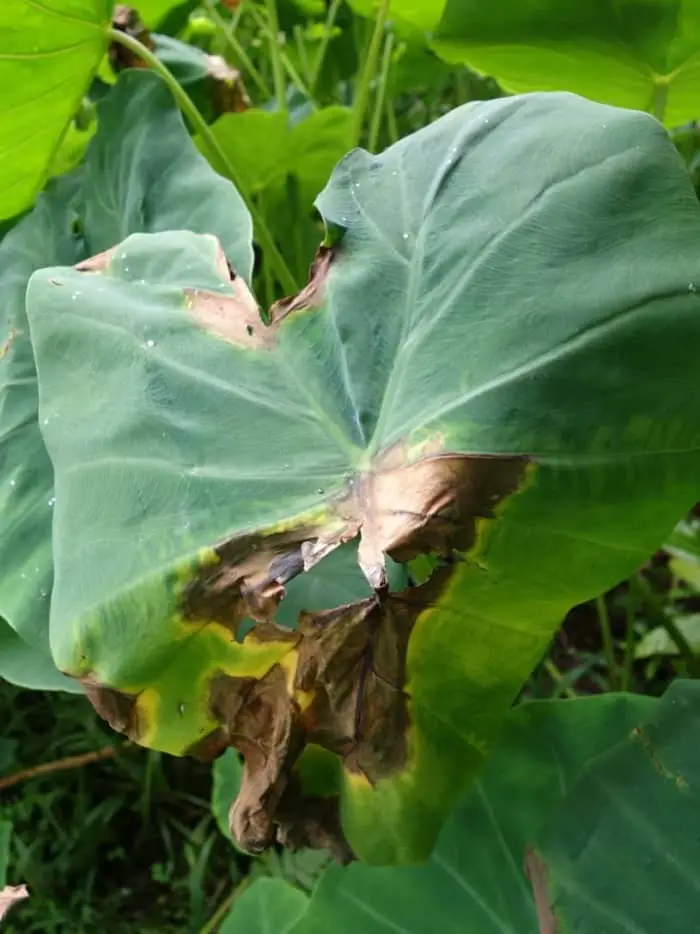
Phytophthora blight on taro leaf
The fungus responsible for Phytophthora blight (Phytophthora capsici) affects all cucurbits including cucumbers but is more commonly seen on squash and pumpkins.
It’s spread through water. So it’s most likely to affect plants that are growing in areas of your garden with bad drainage.
Typical symptoms to look out for:
- A white fungus growing on the fruit
- Plants lose their roots, making them easy to pull out of the ground
- The leaves droop and develop irregular-shaped brown blemishes
You can use fungicide sprays to help with preventing phytophthora blight. But it won’t stop your infected plants from dying. You’ll need to remove them along with the infected cucumber fruits.
White Fungal Growth – Powdery Mildew
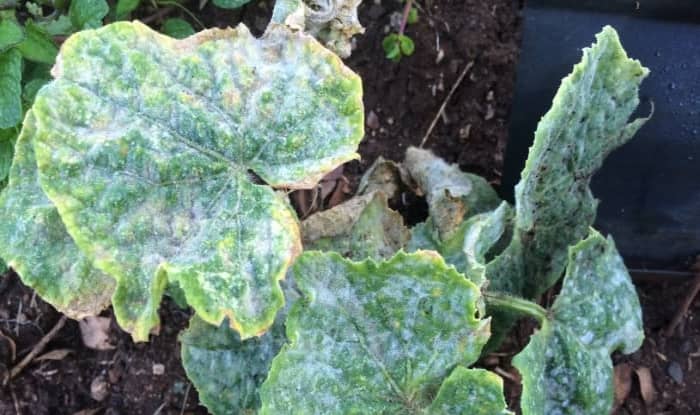
Powdery mildew is caused by a number of related fungi
Powdery mildew is a well-known fungal disease that many gardeners encounter at some point.
The tell-tale symptoms are the cucumber leaves turning white with powdery spots that spread to the stems and sometimes the cucumbers. It also causes the cucumber leaves to turn brown, start to curl, and eventually die.
Plants that are infected produce small and deformed fruit, that are occasionally discolored.
The good news is that it’s possible to save plants that are infected with powdery mildew. Try using a chlorothalonil based fungicide.
Planting your cucumbers where they can get at least 6 hours of sun each day helps with prevention. Because the powdery mildew fungus thrives in shaded areas with high humidity.
And remember to give your plants lots of space, allowing the air to circulate around them.
Brown Spots & Lesions On The Fruit – Rhizoctonia Belly Rot
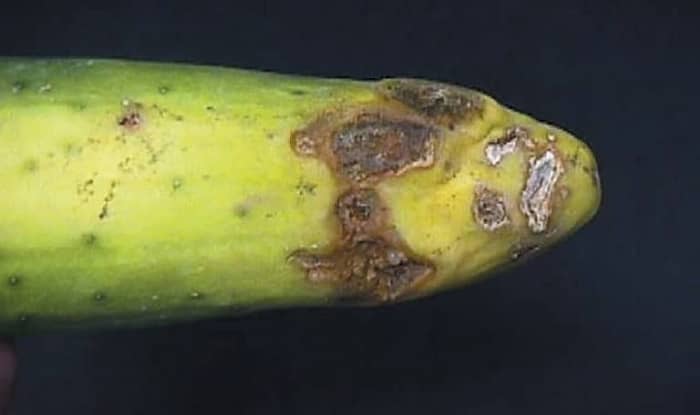
Rhizoctonia solani infection of cucumber, source: David B. Langston/Wikimedia Commons, CC BY 3.0 (modified)
The fungus that causes Rhizoctonia belly rot (Rhizoctonia solani) lives in the soil and is easily transferred to cucumbers that lie on the ground for an extended period of time.
It causes brown spots and lesions to form, which give other harmful pathogens a chance to invade the fruit.
As the disease progresses, the lesions become firm and crusty and can grow deep into the fruit.
You can try removing infected parts of the plant. But there’s no cure for this disease. So if the fungus continues to spread it’s best to remove the plant completely.
Make sure you sterilize the soil and your gardening tools to prevent further cucumber plant problems.
You can keep your cucumber vines away from the ground by using a trellis.
Irregular Yellow & Brown Patches – Verticillium Wilt
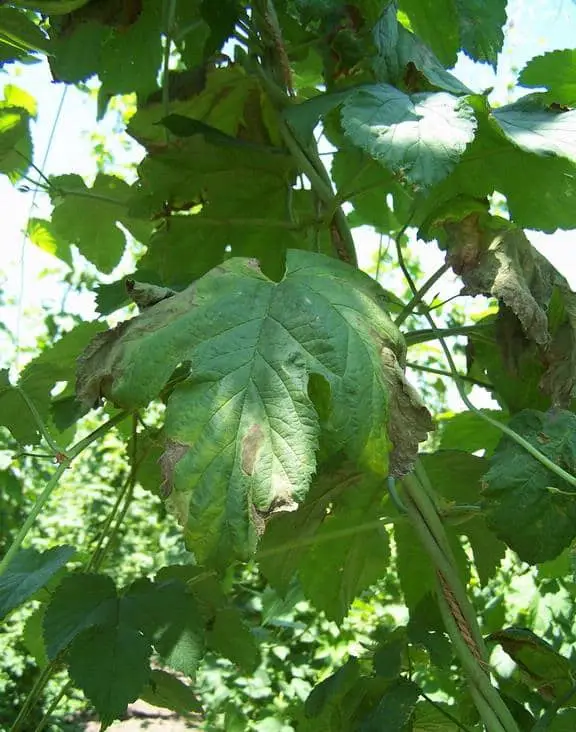
Verticillium wilt on hop leaves David Gent, CC BY-SA 4.0, via Wikimedia Commons
Verticillium wilt (Verticillium dahliae) is another fungal infection that’s most common in warm and wet conditions.
Infection occurs through the plant’s roots. And the symptoms don’t usually appear until after fruit set. You’ll notice the leaves develop irregular-shaped yellow patches that sometimes turn brown.
The fungus spreads through water, garden tools, insects, etc. Anything that can transfer the spores to a new plant.
As there aren’t any effective treatments, it’s best to remove infected plants to stop it from spreading.
The fungus can survive in the soil. So be careful about planting susceptible plants in the same area.
Final Thoughts
Some of the most common cucumber plant problems are caused by the wrong growing conditions, lack of nutrition, inadequate pollination, and exposure to plant disease.
By thinking about how and where you plant cucumbers, establishing a regular watering and fertilizing routine, and making your garden friendly to pollinators, you can provide the conditions needed for healthy growth and yield.
Keep an eye out for any sign of cucumber diseases so you can react quickly. If necessary, consider planting a disease-resistant cucumber variety. And make sure to limit plant pests and prevent infestations that can spread harmful bacteria.
